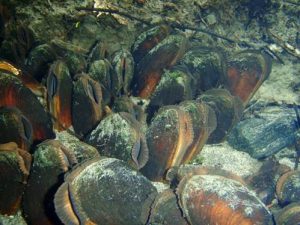Life cycle of freshwater mussles
The freshwater pearl mussel (Margaritifera margaritifera – meaning “the one that carries pearls forward”) is one of the longest living species in northern rivers, where it may live for 200 years or even longer. Its life cycle depends on the two fish species salmon and trout.
The eggs develop to larvae inside the mother mussel during summer. In autumn, the larvae are released. Within a few hours, they then need to find a young trout or young salmon, upon which they attach to the gill of the fish. Until next summer the larvae develops to an 0,5 mm young mussel. Apparently, the encysted larvae do not harm the fish, and may indeed improve its health. The young mussel releases from the fish and falls down into the sandy sediment of the river, where it will live more or less for 20 years, maturing.
Finally, as they are mature, they move to the top of the sediment and stay there filtering the water for nutrients for the rest of their lives.




 This project (EDU-ARCTIC) has received funding from the European Union’s Horizon 2020 research and innovation programme under grant agreement No 710240. The content of the website is the sole responsibility of the Consortium and it does not represent the opinion of the European Commission, and the Commission is not responsible for any use that might be made of information contained.
This project (EDU-ARCTIC) has received funding from the European Union’s Horizon 2020 research and innovation programme under grant agreement No 710240. The content of the website is the sole responsibility of the Consortium and it does not represent the opinion of the European Commission, and the Commission is not responsible for any use that might be made of information contained.